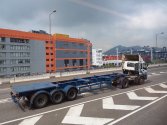The corollary to that is that the US only has a certain window of action after starting direct hostilities in which to achieve a successful military outcome (my rough estimate being 6 months), for if they cannot beat China by the end of that timeframe Chinese industrial power will essentially do to the US what the US did to Japan in WW2.China gains advantage against the US as time passes. Likewise, US is not stupid and it knows the above fact as well.
Common military logic dictates to strike as early as possible to not give time to your opponent to grow. So the prudent action from a military sense would be for the US military to invest in as much short-term capability growth as it can and then strike at China
You are using an out of date browser. It may not display this or other websites correctly.
You should upgrade or use an alternative browser.
You should upgrade or use an alternative browser.
PLA Strategy in a Taiwan Contingency
- Thread starter pugachev_diver
- Start date
There would not be "Taiwan liberation front" in any meaningful capacity, for the simple reason that the petite bourgeoisie is inherently weak and seek to preserve their comfort and wealth above all else, which is the entire reason why they believe in liberalism. But "Give me liberty or give me death!" said the Liberal, no, liberals are literally the least qualified group in the entire history of the world to say this phrase, they are the least likely to engage in violent resistance of all political groups. Insurgency groups have overwhelmingly being Leftist, nationalist or Islamic, those who spout "Freedom" or something immediately get subsumed by the other three within a short period of time.We've already established in this forum that China has a high chance of taking Taiwan. But that's the easy part: how will China control Taiwan? How will China make sure that Taiwan doesn't have some "Taiwanese Liberation Army" running around bombing mainlanders and government outposts? All these require some form of pacification, compliance, and finally acceptance or even joy over the mainland's takeover. Thus, any discussion about potential AR must include how China will manage Taiwan after the initial conquest.
Currently, we have 3 areas that China has applied pacification strategies to: Xinjiang, Tibet, and Hong Kong. Each of them required different methods of pacification but overall there are some trends.
The Xinjiang method is probably the most simple. Using the Bingtuan system, China managed to move numerous Han into the most fertile areas of Xinjiang, thus turning the population into 30-40% Han. Although there was never a mass migration into Uyghur areas, China's control of the most fertile areas of Xinjiang give it a large advantage when dealing with any independence movements. For example, Han make up a plurality in the Ili area, which is more fertile and temperate than the oasis cities the Uyghurs tend to live in. Despite Soviets and Islamists trying to wreck havoc on the reason, China has been able to control Xinjiang using it's comfortable Han majority as well as it's offerings economic development to alleviate minority concerns.
The Tibet method involves breaking the old power structures down (monasteries), replacing it from the bottom up with a completely CCP controlled power structure, and offering rapid economic development as well as decent cultural preservation for the minorities. Unlike Xinjiang, Tibet is a dry, barren land, thus offering little incentive for Han migrants. Furthermore, the high altitude means that many Han will abandon Tibet to get rid of altitude sickness. As a result, Tibet was never going to have a substantial Han minority. Originally, China entered into a proto 1 country 2 systems with the Dalai Lama which left Tibet's old governance virtually intact. However, Dalai's attempt to rebel failed and as a result China dissolved the old system and replaced it with standard CCP governance. But due to Tibetan discontent and outside influence, Tibet was always a rebellious place until China had enough resources to invest in economic development in such a barren reason. In fact nowadays, China sees no point in negotiating with the exile Tibetans because many Tibetans in Tibet are content with their current situation.
The Hong Kong method involved forcing the NSL and reshuffling the legislature. Unlike the other two areas, Hong Kong is still under 1C2S and thus cannot immediately switch to a CCP controlled area. However, using the Hong Kong protests as a rationale, China was able to reshape the power structure in such a way that it would be virtually impossible for any future Legco to declare independence or become a staging ground for spies. Furthermore, Hong Kong is an already economically developed area, thus China doesn't need to provide any strong economic incentive as a part of the pacification strategy. The opposition dissolving was also a help as well. This was all done without destroying Hong Kong's reason for existence: a bridge for foreign capital to interact with China.
Taiwan has similarities and differences with all these 3 areas. Any sort of pacification strategy that China pursues will most likely be a mix of these three.
Thoughts?
They'll protest, they'll mald with fury you've never seen before, but nothing that'll actually put their lives permanently at risk. Of course, the ones you have to watch out for are the ultra-nationalist, but I severely doubt their influence due to their questionable number and conviction.
What must done is an immediate overhaul to Taiwan's education system and restriction of influence, none of the HK protestors that loved the UK lived a day under UK colonial rule, the longer one lived under UK colonial rule, the lower the opinion of the West one has. Those above 20 is mostly set in their political belief, there's little chance of changing it, you'll have to wait for the new generation to grow up under a new education system.
Enacting a full naval blockade against a sovereign country is a hostile act against said country, which in effect, can be considered an outright act of war.
Once that happens - As soon as all options to resolve and lift the naval blockade through diplomatic and show-of-force means by China has been exhausted - Then Beijing should transform her warfighting effort to total war against whoever is conducting the full naval blockade against China (in this case, the US & Lackeys Co.) - Whether the US & Lackeys Co. are directly involved in Operation AR of Taiwan against China or not.
But, if the full naval blockade against China is enacted while the US & Lackeys Co. is already directly fighting China over Operation AR, then all restrains are off. Total war, straight away.
However, it should be noted that unless the US & Lackeys Co. deploys WMDs of any kind against China first, China should not be the first one to use WMDs.
Once that happens - As soon as all options to resolve and lift the naval blockade through diplomatic and show-of-force means by China has been exhausted - Then Beijing should transform her warfighting effort to total war against whoever is conducting the full naval blockade against China (in this case, the US & Lackeys Co.) - Whether the US & Lackeys Co. are directly involved in Operation AR of Taiwan against China or not.
But, if the full naval blockade against China is enacted while the US & Lackeys Co. is already directly fighting China over Operation AR, then all restrains are off. Total war, straight away.
However, it should be noted that unless the US & Lackeys Co. deploys WMDs of any kind against China first, China should not be the first one to use WMDs.
Last edited:
A tiny amount of China’s industrial machine can produce enough munitions to wipe out all the energy infrastructures on hostile nations in the West Pac. The Hegemon will have trouble attacking mainland targets. China can spend a few years to produce enough ships and aircraft carriers to take the war to CONUS.
As an example, China produces about 1.5 million motorcycles every month. If 20% of this capacity is converted to producing Shaheed lawnmower-engine powered cruise missiles, that is 300K munitions per month. Then it is a question of integrating these with the 2000-odd launch trucks in the Army and Rocket Force. Then if you add 2 smartphones, you get stereoscopic vision. That definitely gets you terrain guidance and also terminal optical guidance.
@HighGround
And come to think of it, in a China blockade scenario, we would see production of electric scooters, electric bicycles and electric motorbikes boom as well. Most journeys in the world are short distance, which is especially the case in China because cities are so dense.
You can see electric scooters being sold at just $100 each, and there are over 350 million electric scooters already in China.
So a Ukrainian USV just hit a Russian landing ship from 400+ km away. You can buy high end 160 hp yacht marine engines for $3000 on Alibaba. That's enough to drive a 2-3 ton mini USV with 300 kg payload and everything else being engine and fuel, with electronics being negligible weight.
It can run partially submerged with a polymeric RF transparent air breathing snorkel. The hull can be shaped to maximize stealth above the water and minimize drag below the water. Unlike UAVs these can be pre launched and loiter for months in the middle of the ocean, and can be tasked to tail CBGs, oil tankers and supply ships. And when it comes time to strike, they'll have satcoms to send and receive 2 way data.
It can run partially submerged with a polymeric RF transparent air breathing snorkel. The hull can be shaped to maximize stealth above the water and minimize drag below the water. Unlike UAVs these can be pre launched and loiter for months in the middle of the ocean, and can be tasked to tail CBGs, oil tankers and supply ships. And when it comes time to strike, they'll have satcoms to send and receive 2 way data.
TBH, it would be even better for the PLA, PAP and even the Militia if these kamikaze drones can be fitted into and launched from:As an example, China produces about 1.5 million motorcycles every month. If 20% of this capacity is converted to producing Shaheed lawnmower-engine powered cruise missiles, that is 300K munitions per month. Then it is a question of integrating these with the 2000-odd launch trucks in the Army and Rocket Force. Then if you add 2 smartphones, you get stereoscopic vision. That definitely gets you terrain guidance and also terminal optical guidance.
1. Modules with similar dimensions as (plus camouflaged as) enclosed trailers, which can be towed by literally any semi-tractors across China:

2. And/or modules with similar dimensions as (plus camouflaged as) ISO shipping containers, which can be placed on literally any container chassis trailers and be towed by literally any semi-tractors across China:


3. And/or modules with similar dimensions as (plus camouflaged as) towed campers, which can be towed by literally any SUVs and pickup trucks across China (at the cost of capacity and size):

4. And/or modules with similar dimensions as (plus camouflaged as) towed campers that are even smaller in size, which can be towed by literally any cars across China (again, at the cost of capacity and size):

The possibilities are endless. Of course, all the above suggestions are also applicable for missiles of all types, from mini-size missiles with ranges of only 10s or 100s of meters to large-size missiles with ranges of 100s or even 1000s of kilometers.
If the US & Lackeys Co. wants to hunt for these kamikaze drone (and missile) launchers across China with their precious B-21s while being escorted by NGADs, F/A-XXs, GCAP and FCAS alongside their wingman UCAVs, good luck to them in finding those amongst the hundreds of millions (if not billions) of road vehicles across China.
Last edited:
The launchers being hunted is a very minor threat to begin with. US currently has less bombers than Russia, and besides Taiwan, all of China has at the very least as much strategic depth as Lviv, with non coastal areas being untouchable.TBH, it would be even better for the PLA, PAP and even the Militia if these kamikaze drones can be fitted into and launched from:
1. Modules with similar dimensions as (plus camouflaged as) enclosed trailers, which can be towed by literally any semi-tractors across China:
View attachment 116827
2. And/or modules with similar dimensions as (plus camouflaged as) ISO shipping containers, which can be placed on literally any container chassis trailers and be towed by literally any semi-tractors across China:
View attachment 116828
View attachment 116829
3. And/or modules with similar dimensions as (plus camouflaged as) towed campers, which can be towed by literally any SUVs and pickup trucks across China (at the cost of capacity and size):
View attachment 116825
4. And/or modules with similar dimensions as (plus camouflaged as) towed campers that are even smaller in size, which can be towed by literally any cars across China (again, at the cost of capacity and size):
View attachment 116826
The possibilities are endless. Of course, all the above suggestions are also applicable for missiles of all types, from mini-size missiles with ranges of only 10s or 100s of meters to large-size missiles with ranges of 100s or even 1000s of kilometers.
If the US & Lackeys Co. wants to hunt for these kamikaze drone (and missile) launchers across China with their precious B-21s while being escorted by NGADs, F/A-XXs, GCAP and FCAS alongside their wingman UCAVs, good luck to them in finding those amongst the hundreds of millions (if not billions) of road vehicles across China.
They're also defended arguably with the most concentrated air defenses and CAP in the world. Which is much more than what Russia is going up against.
Russia isn't able to hunt down launchers that far behind the front lines, even with all the air platforms they have. It's not that they couldn't brute force in, but if they do, they'd be trading cheap launchers for expensive planes.
There are chances that launchers in Taiwan could be struck, especially before the PLA has spread out, but those aren't gonna be the high impact launchers in the initial part of the conflict.
By the time any B21 and 6th gen make it into service, they will be in token number, and matched by token numbers of equivalent platforms on the PLA side.
TBH, it would be even better for the PLA, PAP and even the Militia if these kamikaze drones can be fitted into and launched from:.
The Iranians use commercial trucks with shipping containers containing 5 Shaheed each.
But that would require more units to be formed. In contrast, the Army and Rocket Force launch trucks already exist
The Rocket Force will run out of missiles very quickly as they only have is 1-3? reloads.
In any war, there will be a lot of Army Groups which won't be engaged for some weeks. You might as well concentrate those launch trucks and use them for initial massed strikes. Afterwards, there simply won't be enough targets left anyway.
The launchers being hunted is a very minor threat to begin with. US currently has less bombers than Russia, and besides Taiwan, all of China has at the very least as much strategic depth as Lviv, with non coastal areas being untouchable.
They're also defended arguably with the most concentrated air defenses and CAP in the world. Which is much more than what Russia is going up against.
Russia isn't able to hunt down launchers that far behind the front lines, even with all the air platforms they have. It's not that they couldn't brute force in, but if they do, they'd be trading cheap launchers for expensive planes.
There are chances that launchers in Taiwan could be struck, especially before the PLA has spread out, but those aren't gonna be the high impact launchers in the initial part of the conflict.
By the time any B21 and 6th gen make it into service, they will be in token number, and matched by token numbers of equivalent platforms on the PLA side.
In addition, why would the US be hunting low-cost missile launch trucks, when there is a much juicier target in terms of fixed airbases where expensive aircraft are located.
And remember they would need to deal with the Chinese Air Force anyway, if they wanted to hold the First Island Chain.
I don't disagree, but I think that's what policy analysts are banking on. They probably believe that they can justify blockading China.
And yeah, it's obviously going to goad China into a first strike, but that will also allow United States to retain the "moral advantage" and help rally its allies to help against China.
Theoretically.
I've seen the study that alleged that China has a potentially 8 year hold-out time.
I am highly skeptical of this claim. In my opinion, that was a rudimentary exercise in essentially napkin math, rather than a genuine analysis of how long China can last. (I believe the hold-out time to be significantly shorter)
I think the most obvious conclusion, is that any large-scale embargo of China is going to be extremely painful for everyone. But the idea here is that while the rest of the world would be damaged, it would carry on. Whereas China would be on a ticking clock if the West can convince major energy suppliers (minus Russia) to embargo China.
Theoretically.
These ideas are obviously completely insane and unfeasible in my opinion, but why else would USNI, RAND, STRATFOR, and other think tanks/publications/government offices bother gaming out these scenarios?
And people like Mastro are the ones who help write these reports out.
We already saw how F’d up the global economy became with Covid. Once things aren’t coming out of China full speed, shelves become empty. Shelves empty means jobs dry up.
Good luck with those economic blockade plans…
